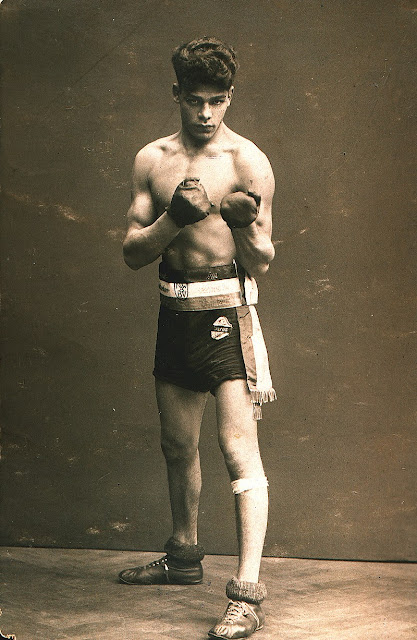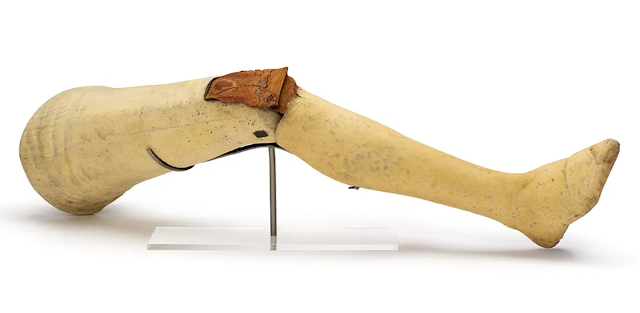ROMA HISTORY: Boxer: The Life and Death of Johann Trollmann
Content Warning: Racism, Violence, Murder, Genocide.
This is the story of Johann Wilhelm ‘Rukeli’ Trollmann. You’ve probably never heard of him. He was a famous Sinti Romani boxer in the 1920s. The reason that, particularly in the English speaking world, he is not particularly well known is because of the events described in this post. Part of the goal in writing this is to draw more attention both to Trollmann himself, and also to the suffering undergone by the Roma including the Sinti during the genocide carried about by the Nazis and their allies. It is a story of pain, suffering, and defiance, and both the story and the man deserve to be remembered.
 |
| Johann Wilhelm 'Rukeli' Trollmann as an amateur boxer in 1928 |
Johann Trollmann was born on 27 December 1907, at Wilsche
near Gifhorn in what was then the German Empire. In the 1920s he rose to fame as a skilled
boxer, known for his technique, hand speed, and movement. He was the North German champion in the light
heavyweight division before his 20th birthday. At 21, despite his fame and reputation, he
was barred from boxing for Germany at the 1928 Summer Olympics. The justification for his exclusion was that
his style of boxing – traditional among the Sinti and Roma more generally, relying
on movement, quick footwork, and fast reflexes – was ‘not German enough’. In retrospect this could almost be a foreshadowing of things were to come.
Trollmann turned professional, fighting as a
light-heavyweight. After the Nazis came
to power, after the 1933 Reichstag fire, the German light-heavyweight champion
Jewish boxer Erich Seelig fled the country, leaving the title vacant. And so a match was set for the title between Trollmann
and Adolf Witt to take place on 9th June 1933. With Trollmann leading on points, local Nazi
officials – nervous at the possibility that a Sinti boxer would become champion
– pressured the referee to call the bout a No Contest. This caused a near riot and the officials were
forced to hand Trollmann the title. Six
days later Trollmann was stripped of the title.
The official reason was ‘bad boxing’.
A new fight was scheduled, again for the officially vacant
light heavyweight title, between Trollmann and Gustav Eder. Before the fight Trollmann was given a
warning. He was told that if he ‘danced
like a Gypsy’ in the ring, he would lose his boxing license and never fight
again. He was told he had to fight like
a German. This would lead to an epic act
of defiance in the face of prejudice. When
Trollmann arrived for the title fight he looked nothing like he had when he had
faced Adolf Witt. He had bleached his
hair blonde, and covered his skin with flour to lighten it. He had in effect turned himself into a
caricature of the Nazi’s ideal Aryan German boxer. But this was not the end of his
defiance. Once in the ring, Trollmann
did not throw a single punch. He stood
and without defending or protecting himself, he faced the repeated punches of Gustav
Eder for six rounds before finally collapsing unconscious from the
exhaustion.
No-one can say for certain if the pressure continued after the
title bout, but some sources say that after embarrassing the Nazis in the title
fight against Eder, he was threatened with violence against his family if he
did not lose. It is notable that
Trollmann’s fight record changes after that single bout. Prior to it he had won the vast majority of
his fights, while after it he recorded only one win, and one draw. He was still however famous for his earlier
career and well known in Germany, even as the persecution of the Roma, including
the Sinti began to increase. The Roma
were considered an undesirable people and under the Nazi race laws Roma and
Sinti men were forcibly sterilized to prevent any growth in the population. In the majority of cases this was a prelude
to be interred in concentration camps.
In 1939, Trollmann was conscripted in the Wehrmacht and eventually was sent to fight on the Eastern front. Consider for a moment being forcibly conscripted into the army and sent to fight for a nation which considered you to be something less than human. Those who rebelled with the penal battalions which were made up of both soldiers and civilians were sent to Sachsenhausen concentration camp or simply executed in the field. Trollmann was wounded in 1941 and sent back to Germany.
 |
| The 'Brown' Triangle was used to identify prisoners as being Roma / Sinti. |
In June 1942 he was arrested
by the Gestapo, and sent to Neuengamme concentration camp. Once interred in the camp Trollmann did his
best to keep a low profile, but his fame caught up with him. The commandant had been boxing official
before the war and recognised him straight away. He ordered that Trollmann be used as a
trainer for his troops and the guards.
So after days of back breaking forced labour, Trollmann was forced to be
a trainer. The repeating strain of his
body began to break him and his health deteriorated rapidly. The underground prison’s committee within the
camp decided something had to be done to try to save the famous boxer’s life
before it was too late.
Using forged documents, the prisoners faked Trollmann’s
death and managed to get him transferred under a false identity into the
adjacent camp at Wittenberge.
Unfortunately he was once again recognised, and could not hide from his
fame and reputation. Prisoners, possibly
with the knowledge and involvement of the guards, arranged for Trollmann to
have one more fight. His opponent was a
man named Emil Cornelius. Cornelius was
a hated Kapo, whom the prisoners wanted to see beaten. As a Kapo, Cornelius was responsible for overseeing
the hard labour being done by the prisoners.
Many Kapos were former criminals working in exchange for reduced sentences
– some of whom were from violent gangs – while others were prisoners who took
the decision to become collaborators to save their own lives or those of their families. And so Trollmann faced his final opponent. One account handed down from a survivor said
that Trollmann boxed his own style once more.
He defeated Cornelius with the practiced skill of a man who should have
represented his country at the Olympics, who should have been a champion. But Cornelius would use his position in the
camp to carry out a brutal revenge. Not
long after the fight Cornelius forced Trollmann to work all day as punishment,
waiting until to the boxer was too exhausted to defend himself before attacking
him. The former champion boxer died, beaten
to death with a shovel, aged 36 in April 1944.
Trollmann’s entire life and his boxing career were shaped by
the persecution of the Roma and the Sinti under the Nazis and their
supporters. Barred from the national
team, turning professional and being blocked from a title he had won fairly. Conscripted, wounded, arrested, imprisoned,
abused, murdered.
 |
| 9841- Temporary memorial for Johann Rukeli Trollmann in Berlin-Kreuzberg |
In 2003, 70 years after he was stripped of the title for ‘bad boxing’, the German boxing federation finally acknowledged that Trollmann was the 1933 Light Heavyweight Champion. In 2010 a temporary memorial would be set up in Victoria Park in Berlin by the German art collective Bewegung Nurr. Titled ‘9841’ after Trollmann’s prisoner number the sculpture is of a boxing ring with one corner lower to the ground and one higher.
In 2015 the Italian music group
C.F.F released the song ‘Come Fiori’ about Trollmann’s life. The opening lyrics (translated from the
original Italian) read:
It's not Hurricane, nor Rocky vs. Drago
nor Million Dollar Baby or Raging Bull
this is the story of an entangled boxer
between pieces of memory and barbed wire.
Born "gypsy to be sterilized"
the dance of the boxing gloves made people fall in love
my fame as a champion exploded in Hanover
for everyone Rukelie - the tree - was my name.
Trollmann's nickname 'Rukeli' comes from the word for tree
in several dialects of Roma. One witness
who remembered seeing Trollmann box in the 1920s and early 1930s when he was a
young boy, would later see Muhammad Ali, and would remark 'He fights like
Rukeli...'
The story of Trollmann is one of defiance in the face of
aggression and prejudice. It is a story that
deserves to be told and to be remembered not just for his sake, but for the
sake the millions of lives impacted by the deeds of the Nazis and their
sympathisers from those days to the modern age.
Outside of Germany – where a documentary was produced in 2013 but which
is now very hard to find, and Italy where Trollmann’s story is known through a number
of works of art including music, and outside the Romani community, his story is
largely unheard of.
The story of Johann Wilhelm ‘Rukeli’ Trollmann, a Sinti
Romani boxer who fought against prejudice, who was barred from representing his
country because he was the wrong race and his boxing style which was in many
senses far ahead of its time. A true champion.




